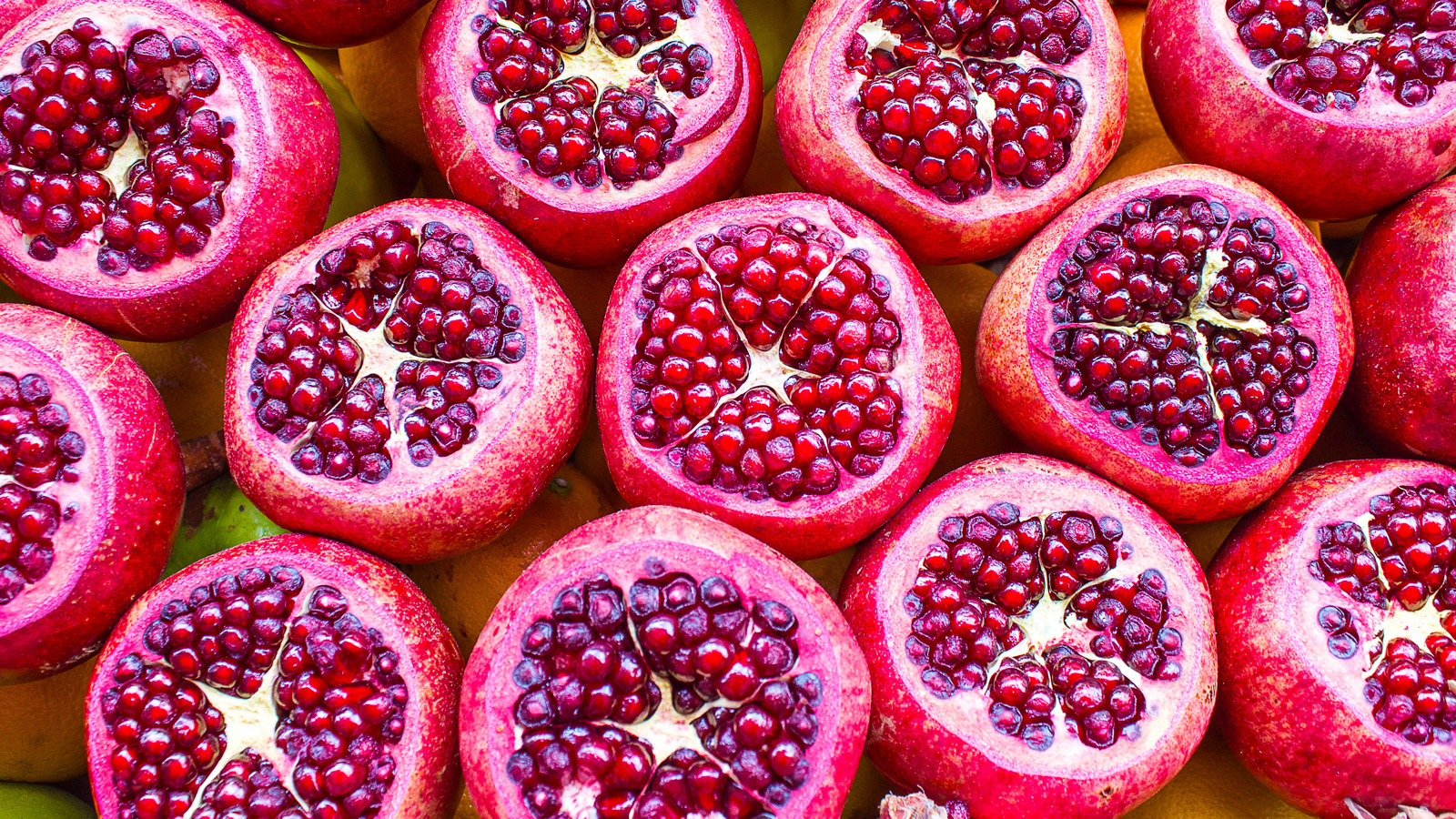
When you learn how to grow pomegranates, there’s one maxim to be sure of: all good things come to those who wait! With its juicy clusters of ruby fruits encased in shiny, flushed amber-gold jackets, this formerly Persian delicacy brings a flourish of luxury to the kitchen garden. Just don’t expect a fast fix. Pomegranates are now being widely embraced for being exotic and easygoing; seasonally diverse, disease resistant, drought tolerant, and almost too good to eat. But these vibrant fruity jewels are not to be rushed – either as a gourmet ingredient in a superfood salad, or as a freshly planted juvenile tree feeling its way in new ground.
If you want one of the best fruit trees that delivers outside the harvest window, growing pomegranates (Punica granatum) is full of surprises. As well as being cultivated for their juicy fruits, these sun-seekers make stunning ornamentals. Possessing glossy leaves that age from copper to green to gold, plus a rich splash of orangey red floral trumpets in early summer, pomegranates make vivid specimen shrubs in their own right. They are even known to entice hummingbirds, such is their allure.
One of a modern breed of ‘superfruits’, a single pomegranate is said to have more than three times the level of antioxidants found in a glass of red wine or a cup of green tea. They are heart-healthy, super-nutritious, bursting with anti-inflammatories, ideal for lowering blood pressure, diabetes and the risk of arthritis, and potent memory-joggers. They also taste divine. So take time to find out how to grow your own delicious pomegranates. Trust us, you won’t be disappointed…
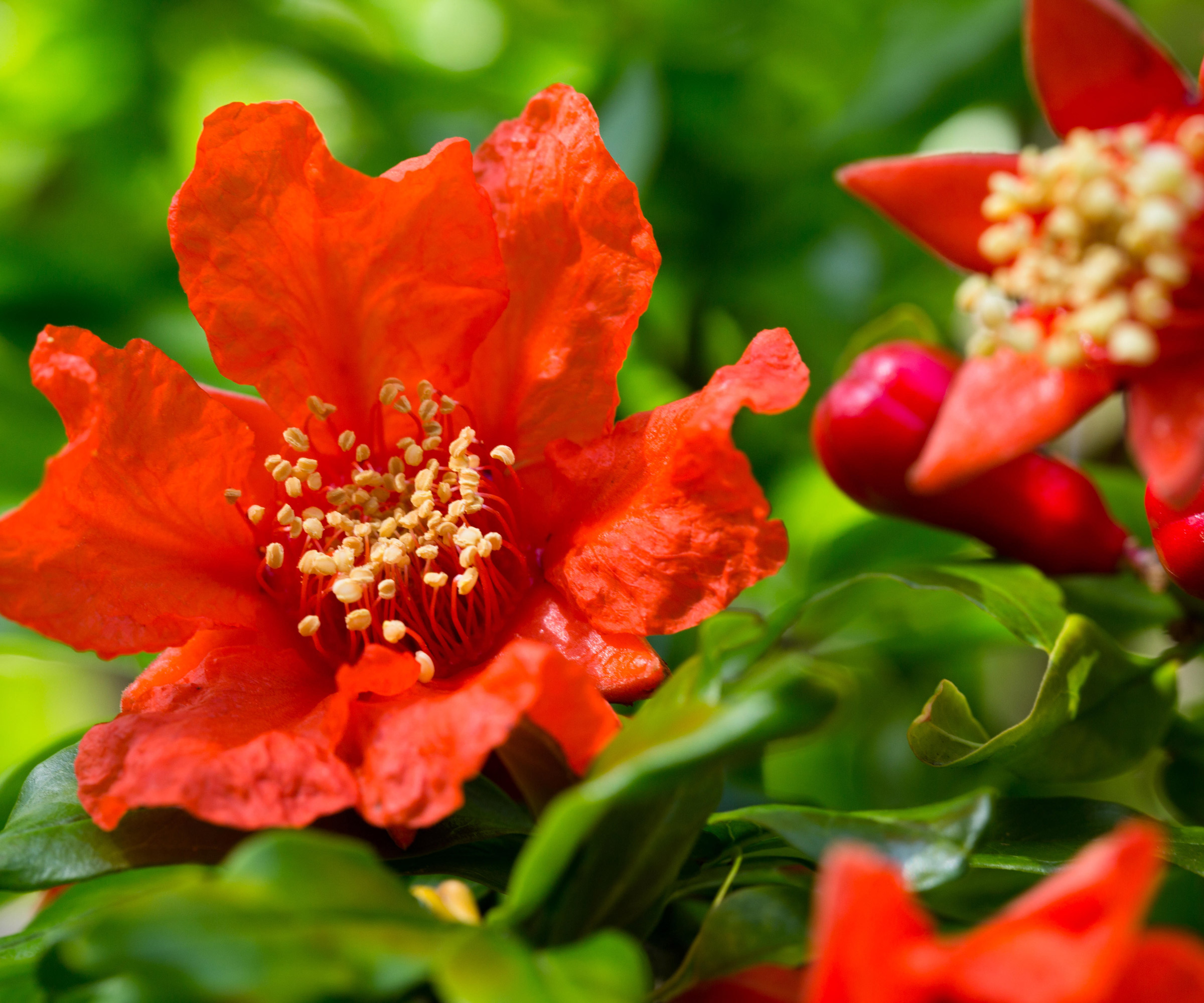
Ideal conditions for growing pomegranates
While this proclaimed ‘fruit of royalty’ sprang forth in the walled gardens and courtyards of Persia, it also found favor in Asia, India and Northern Africa. Its fondness for a sun-soaked atmosphere is key to identifying how to make the most of it. So you’re in luck if you’re after plants suited to a Mediterranean garden, an exotic addition to a border near a garden wall, or the best fruit trees for small gardens. But the basis for growing pomegranates is simple: ample sunshine (and plenty of it), a decent space, moisture and drainage.
Pomegranates can cope with most kinds of soil except thick, claggy types or heavily waterlogged earth. However, as Maureen Wright of Fast Growing Trees advises, they are happiest in well-drained loamy soils with a slightly acidic or neutral pH (5-5-7). ‘Pomegranates do best in soil that doesn’t get too saturated. If they sit in water for prolonged periods of time, it can cause problems with root development,’ says Maureen. If you are not sure which soil type you have, do a test before planting so you can make adjustments, either by conditioning the earth with aged compost or lowering the pH levels with some sulfur-based granules.
Assess your space as this will help inform you as to whether you select a dwarf or standard size of plant, and how many you’ll comfortably grow. Dwarf shrubs reach 3-4ft, whereas standard trees can average 16ft (and some reach 25-30ft).
And pick a sheltered spot you know will get six hours of direct sunlight a day – preferably more, as head horticulturist Tim for Nature Hills Nursery points out. ‘Pomegranates need a sunny location, although they may tolerate partial shade,’ says Tim. ‘They like hot, dry summers and cool winters for the best growth.’ A south, west or east-facing garden is ideal. And these crops grow best from pot-based or bare-root plants, available at garden centers and mail-order suppliers.
- Buy pomegranates plants from Etsy
- Buy pomegranates plants from Fast Growing Trees
- Buy pomegranates plants from Nature Hills
- Buy pomegranates plants from Walmart
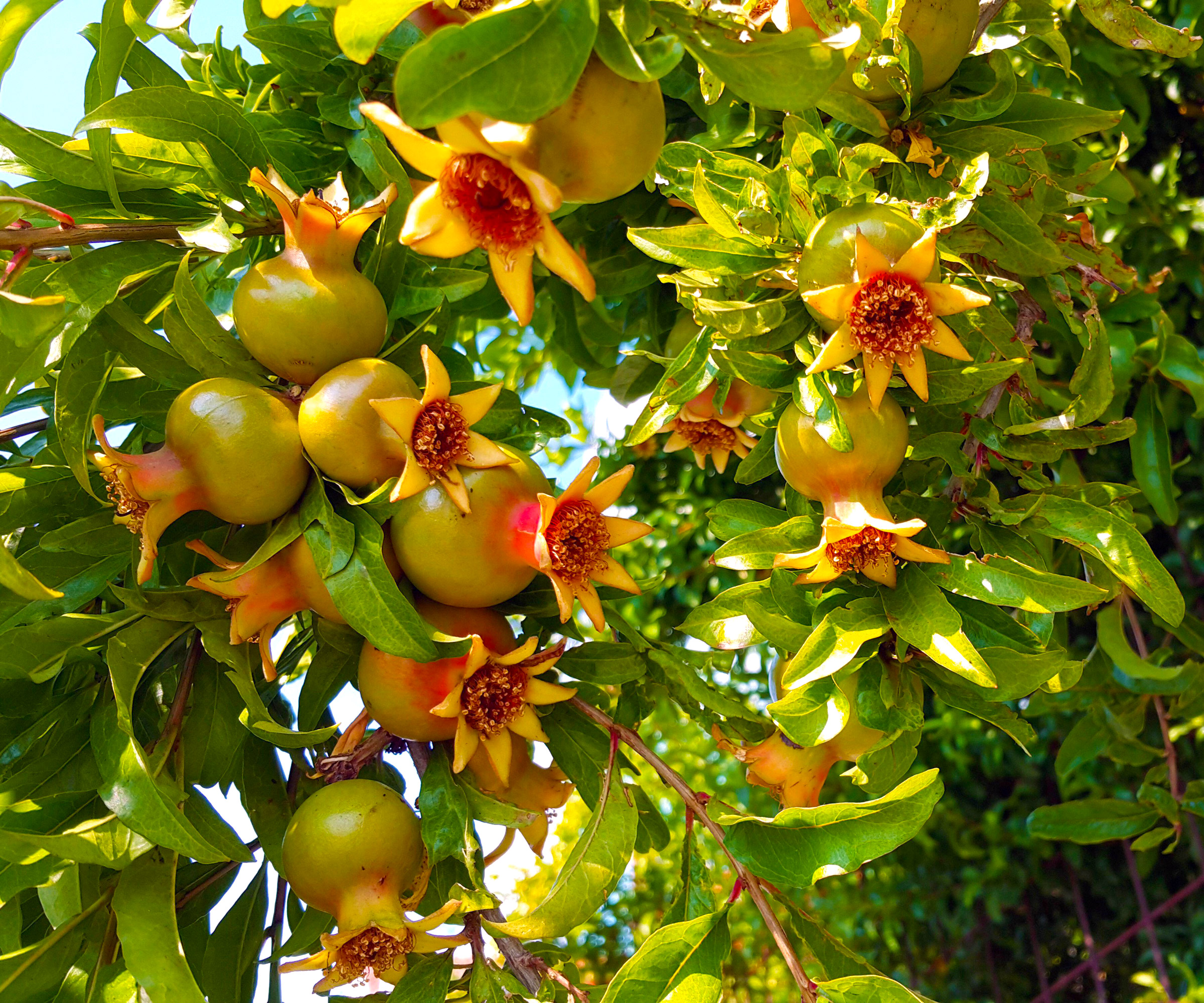
When and how to grow pomegranates
You can grow pomegranates as trees or shrubs, depending on the variety and space available. They can be grown as deciduous or evergreen trees, based primarily on the coolness of the winters in your area.
Deciding when to plant fruit trees also depends on where you are planting them. Just remember they crave long, hot and dry summers to give fruits maximum exposure to light and warmth. They are most likely to flourish in USDA hardiness zones 7-11. The best times for planting young trees are in spring, once the last risk of frost has passed, or in the fall at least six weeks before the first winter frost. Both options allow the plant to settle and establish a little ahead of a full growing season.
If planting in the fall, protect plants from frost and keep protective measures on standby. As Maureen Wright points out, temperatures below 12˚F can cause damage, particularly to younger trees. Exposure to frosts can stunt growth and weaken plants, making them prone to infections. Maureen recommends mulching at the base of the tree to defend from sudden climate variations. ‘For an added layer of protection, cover the tree in burlap ahead of really cold nights,’ she says. You can also use horticultural fleece or even an old blanket propped up on canes.
Some pomegranate trees have been bred for extra hardiness. Maureen recommends the versatile ‘Cold-Hardy Red’ (available from Fast Growing Trees) for cooler zones, pointing out that it can thrive even in zone 6. She also namechecks ‘Texas Pink’ and later-season ‘Wonderful’ (both also from Fast Growing Trees) as being excellent varieties to try. Dwarf ‘Nana’ is cold-hardy to zone 7, while ‘Sweet’ is a strong early variety. Homes & Gardens’ growing expert Lucy Chamberlain also recommends the robust variety ‘Provence’ if you want to make sure you don’t fall foul of unpredictable winters and cold snaps.
Planting in pots gives more flexibility with smaller breeds and dwarf varieties. ‘In colder climates, they can be grown in containers outdoors in summer and moved into a sunny location indoors for winter,’ says Tim at Nature Hills. Deciding to grow pomegranates this way gives more control over the planting season and means you can keep young specimens safe when cold snaps are forecast.
And as Lucy Chamberlain points out, one of the best things about learning how to grow pomegranates is that they are self-fertile. Because they are self-pollinating, this means it’s fine to grow one on its own – and you can still enjoy a fruitful harvest.
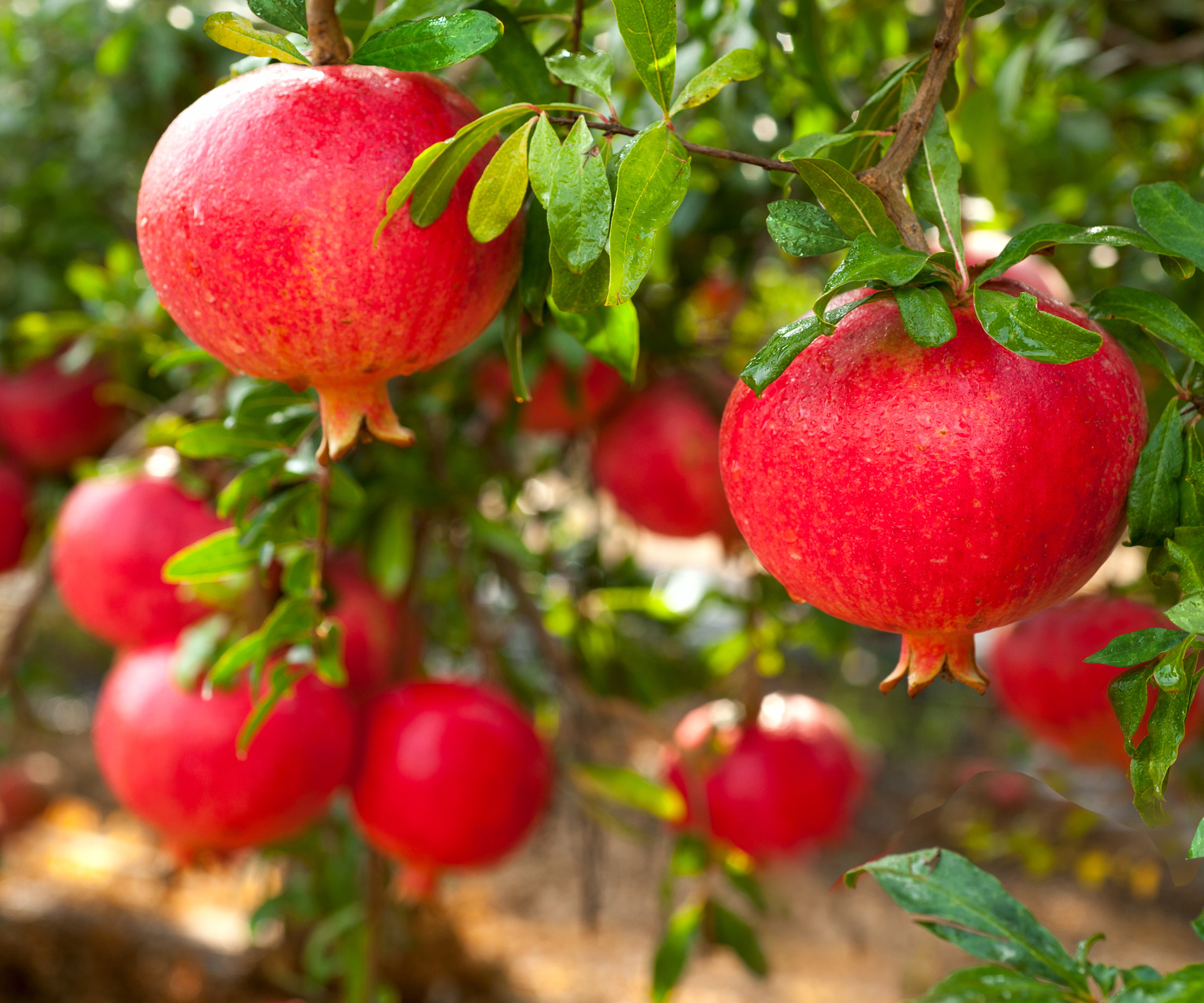
How to plant pomegranates
As long as you are sure there is no risk of frost, the main task before learning how to plant shrubs like pomegranates is soil preparation. Maureen Wright at Fast Growing Trees urges you to test soil to ascertain whether you need to treat the earth before growing pomegranates: ‘Doing this will help determine what (if any) pH, nutrient or consistency amendments you need to make. Your local county extension office can provide low-cost testing if you provide soil samples,’ says Maureen.
While pomegranates are fine in poor soil up to a point, they fare better if you condition the earth first with a compost tea, a slow-release granular feed, some fish bone and blood, or a little aged loam, compost or similar well-rotted organic material.
As well as preparing garden soil with a fertilizer, make sure the soil is loose and well draining for healthy, strong root systems. You can boost the structure and air levels in soil using a rake or rotavator. Aim to do this at least a month or six weeks before planting. Then follow these steps from Maureen White for planting bare-root pomegranates (late fall) or potted trees (spring):
- Dig a hole in the earth that is approximately double the width of the root ball of the tree and about as deep. Add a little slow-release fertilizer to the base of the planting hole.
- Slide the tree out of its container and carefully loosen the feeder roots (the hairlike roots and tips you see when you pull the tree out of the pot). Gently run a hose through them so they spread out before placement.
- Place the tree in the hole. Make sure any soil line on the tree is level with the surrounding soil. If you are planting a bare-root tree, a stake can help support the tree until it develops a stronger root system.
- Backfill the surrounding soil around the root ball and gently firm down the soil with your hands to stabilize the tree. Once in place, water in well and add more soil as necessary. Add a light mulch (avoiding the trunk).
- If you’re planting multiple pomegranate trees, space them 18 feet apart so they have plenty of room to grow. If you want a row of smaller shrubs (maybe as a border), space them roughly 6-9ft apart.
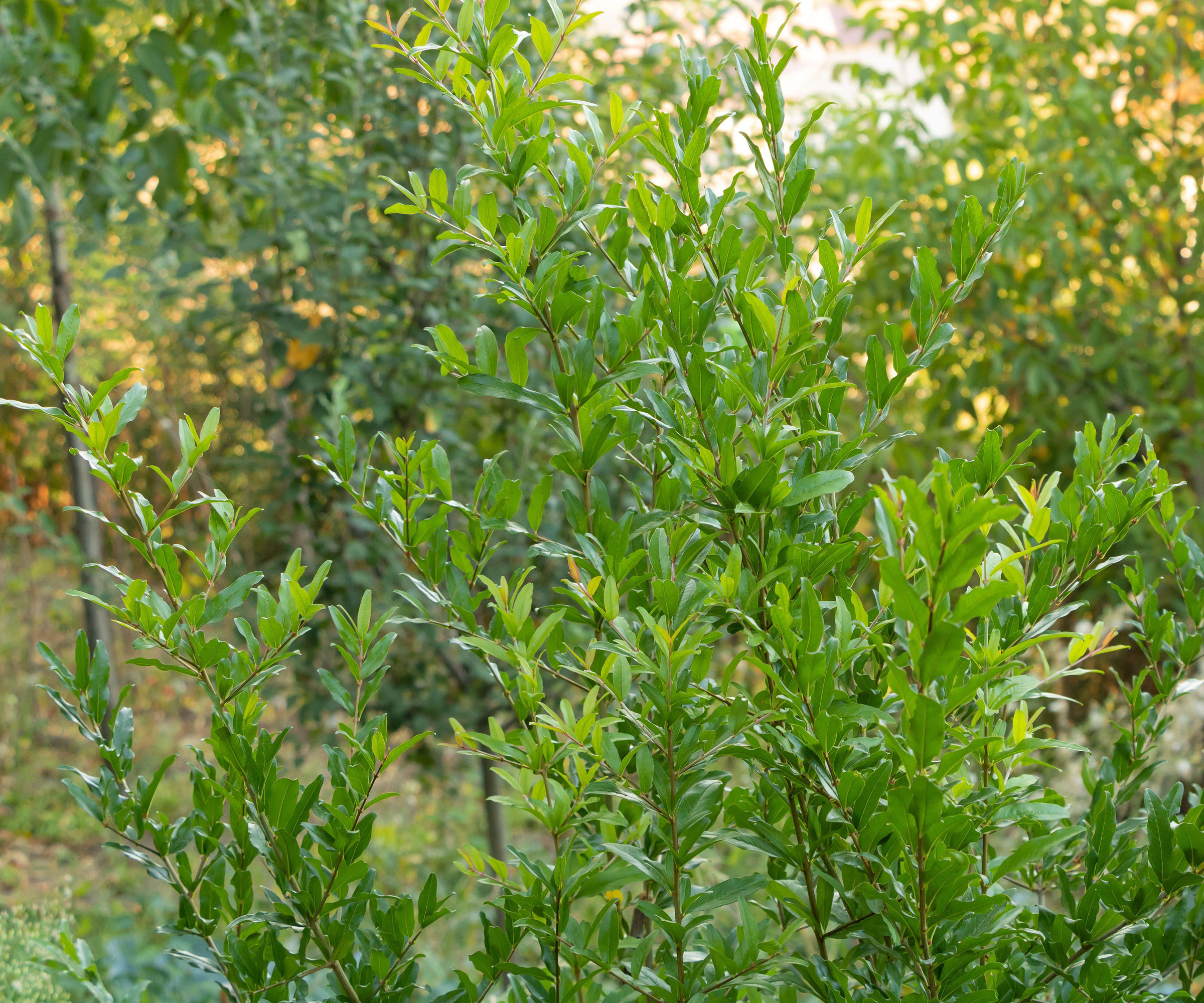
How to grow pomegranates in containers
Growing pomegranates in containers allows you a little more freedom over placement. As well as being able to move them inside for the winter months, you have the advantage of relocating them should you struggle with your first growing location.
They are some of the best fruit trees to grow in pots, as long as you stick to dwarf breeds, smaller varieties or container-friendly grafted trees. It’s also important that you grow in a good-sized container, maintain generous levels of sunlight and warmth, and keep a close eye on watering and feeding. Keeping outdoors during summer is essential, but over winter they are best relocated inside to a well-lit sunroom, greenhouse or sunny windowsill.
Dwarf variety ‘Nana’ is a firm favorite for container gardening, being one of the smallest pomegranates you can grow as a tree. It reaches 3ft tall and is popular as a bonsai. Heritage ‘Provence’ is a fine cold-hardy choice for larger containers. ‘Alhambra’ is a dazzling ornamental option, even if it only reaches 1.5ft high.
As Burpee’s horticultural specialist Nancy Awot-Traut says, variety will determine pot selection (specifically, size). Small breeds need containers with a 2ft diameter and 1.5ft depth, says Nancy, while plants likely to reach 6-7ft high need a pot 3ft wide and 2ft deep. A half-barrel with drainage holes is perfect. ‘When in doubt, opt for a slightly larger container,’ says Nancy.
Drainage is essential, as is watering. One of the biggest container gardening mistakes is to misjudge moisture levels when you grow pomegranates in pots. So don’t let the compost get waterlogged, or allow it to dry out. Immediately after planting, be sure to water in well, firm down, and add a mulch to help retain moisture levels.
Newly planted potted pomegranates, in particular, need a lot of hydration to develop properly, says Nancy. ‘Water thoroughly once a week,’ she says. ‘When fully mature, the tree is a bit more drought-tolerant, so you may not have to water quite as often,’ she adds. Just top up during hot, dry spells, and boost potassium levels every month with a general-purpose fertilizer.
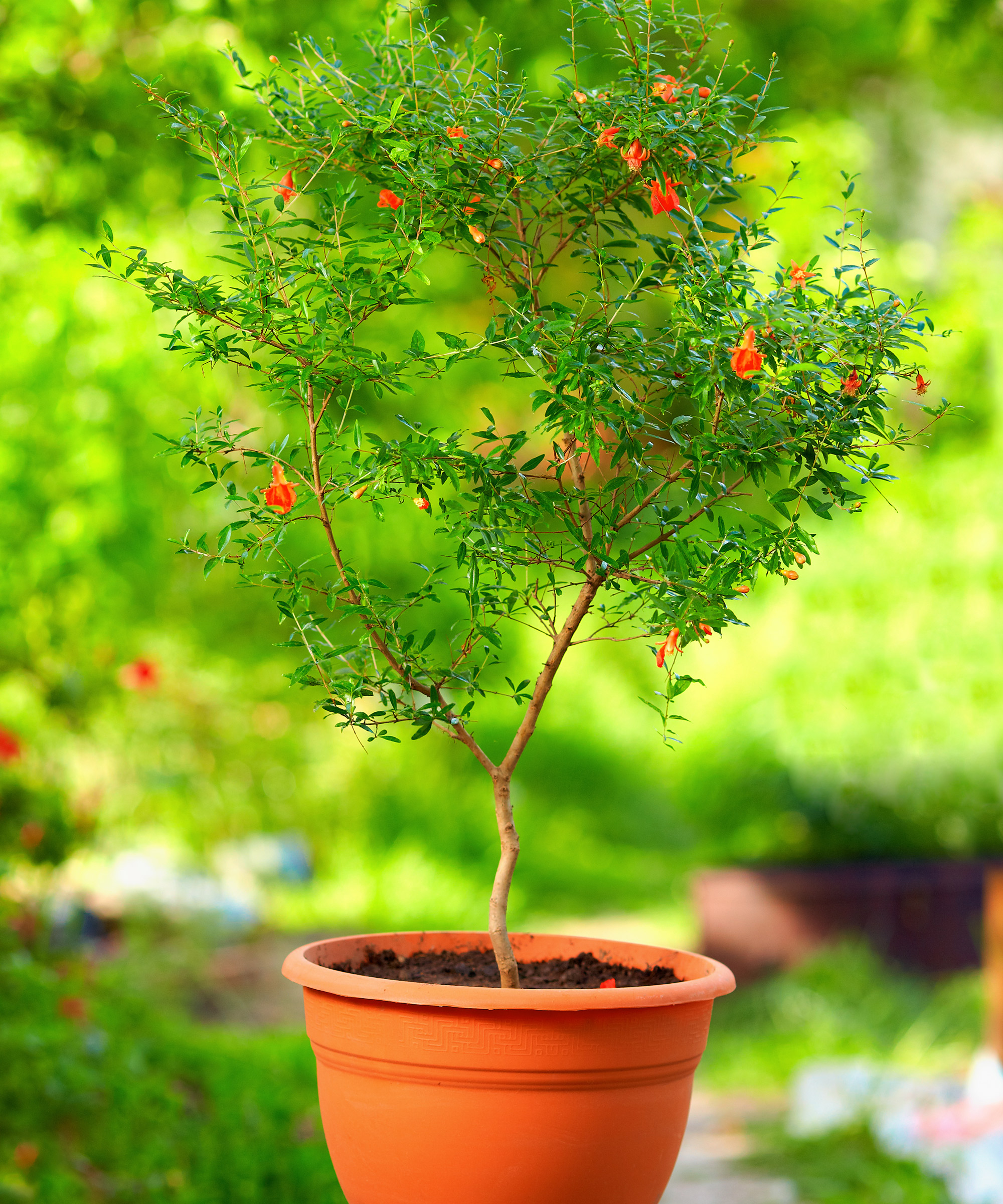
Pomegranate care tips
Once safely planted, the process of growing pomegranates relies on a regular diet of sunlight, water and warmth in abundance. When it comes to watering, there is a definite knack to doing it right, as Maureen Wright explains.
In terms of when to water plants, it’s something you should be doing more for younger trees (established pomegranates are more drought-tolerant). ‘Most of the younger tree’s energy goes toward root development and pushing out new growth,’ says Maureen. ‘Make sure you’re consistently watering deeply, particularly in drier weather.’
Soil condition will have a part to play, and you need to avoid over-watering. Tim at Nature Hills advises letting soil dry out between waterings, while Maureen encourages you to always test the soil’s moisture levels first. Dig your finger into the soil and if it still feels damp, it’s fine to leave it.
Burpee’s Nancy Awot-Traut also highlights the benefit of feeding with a high-quality organic granular fertilizer in spring, while Lucy Chamberlain also suggests regular doses of a high-potash liquid feed to help fruits reach a good size (once a month during the growing season). Slow-release types are gentler for root development. Make sure your feed includes a good level of potassium, so the tree puts energy into fruiting, and nitrogen, which encourages healthy foliage. During the first couple of years, it’s good to feed again in late fall, and again the following spring. Once you have had the first harvest, you can reduce feeding apart from twice-yearly top-ups. If you over-fertilize plants it can lead to weak or poor harvests.
Anyone looking to grow pomegranates that come back stronger year after year will find trees and shrubs benefit from a generous topdressing of aged compost (or similar organic material) between winter and spring each year. Doing this when trees are dormant means they return with a kick in the next growing season. You should also add a good mulching early in spring each year to help keep moisture levels regulated for the dryer months ahead.
Tim recommends a little light pruning in late winter. Nancy advises removing dead or diseased branches, plus any excess growths developing at the base of the shrub or tree, just leaving a few where you need new branches to grow. ‘If you don’t trim these, especially in the first couple of years, you’ll end with a very bushy tree. This won’t be conducive to healthy fruit production, because its energy will be focused on keeping foliage sustained instead,’ says Maureen.
Lovers of companion planting will find pomegranates make better progress planted near daisies and fennel, which entice natural predators like lacewings and ladybugs that fight off aphids. Pomegranates also do well planted near lavender, thyme, cosmos and zinnias, which can boost pollination levels. Alternatively, take matters into your own hands with pollination and use a paintbrush to transmit pollen between flowers.
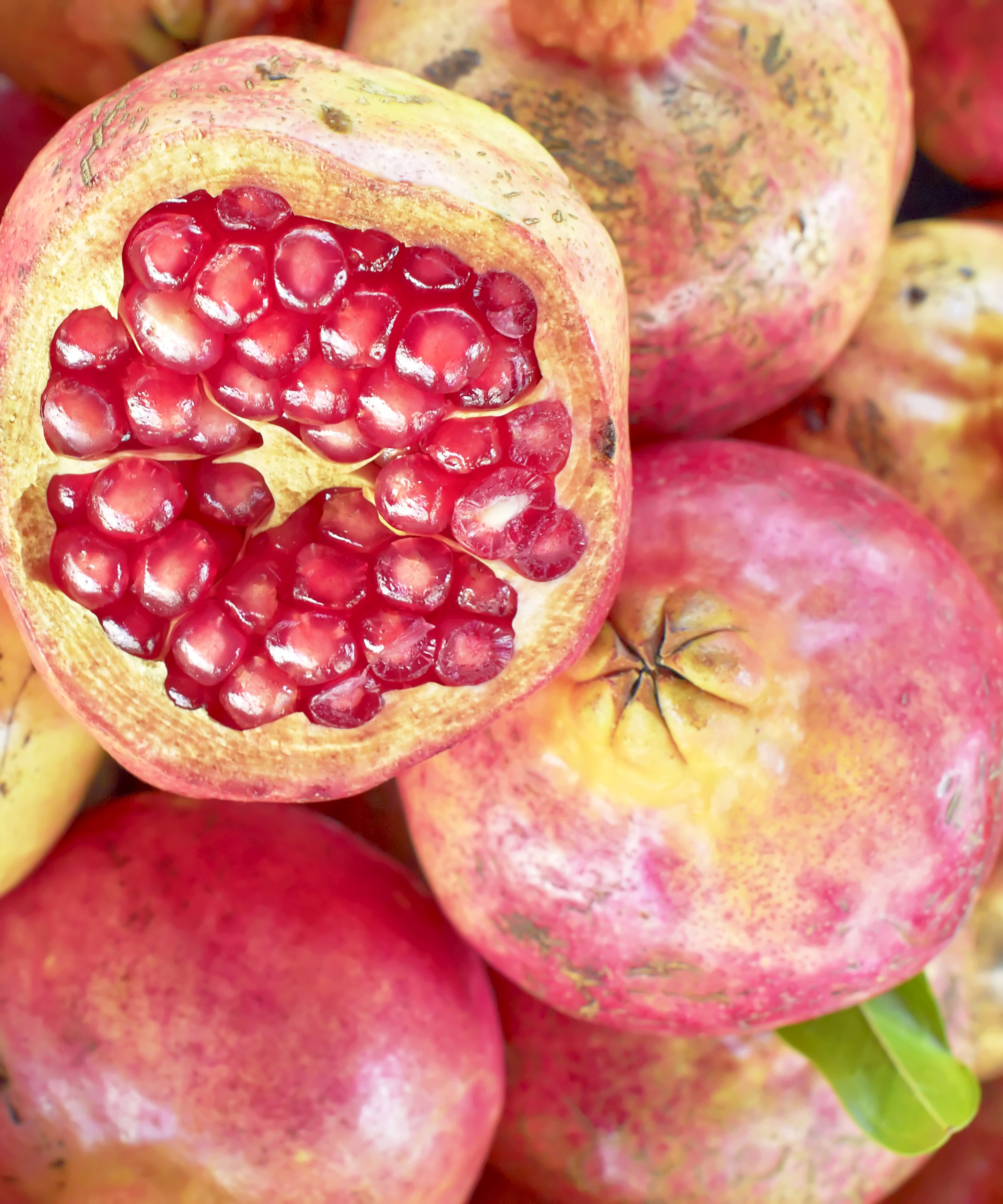
Problems growing pomegranates and how to tackle them
The good thing about learning how to grow pomegranates is that they are resilient to a lot of the pests and diseases that befall other types of fruit trees. ‘Leaf spot can occur, but a copper fungicide spray can solve that quickly when it’s caught early,’ says Maureen Wright.
Fruit rots and fungal infections may also occur where trees are exposed to overwatering or heavily saturated soils. A regular organic fungicide can halt the damage. The most important thing is to monitor soil health and ensure the ground is well draining and that you allow plenty of time between irrigating trees and shrubs. Conversely, beware underwatering, which can cause yellowing leaves in the growing season. Also, watch out for chlorosis, which presents as ‘bleaching’ in fruit and is a symptom that the tree is deficient in potassium (a good feeding regime can prevent this).
Certain pests also cause leaves to change color and drop. One of the most likely causes of pest damage will be aphids. You can get rid of aphids by encouraging ladybugs and lacewings. Grow plants like dill, cosmos, daisies and fennel nearby, which are conducive to their presence. You can also target aphids with short bursts of water on leaves every other day or by spraying with mild soap or horticultural oil.
Other pests like mealy bugs, whiteflies and pomegranate butterflies are generally prone to feed on branches that have been infected due to bad pruning. Good pruning practice is your best line of defence for keeping most of these pests at bay. The only other pest that is likely to need some form of defence is the garden bird! Sadly, birds will love your pomegranate fruits, so consider some form of netting (make this well secured, supported and safe, using a cage or a frame, so birds don’t get trapped).
There is one more rather unusual problem that can happen when growing pomegranates, and that is ‘splitting’. This is a phenomenon where fruits seem to ‘explode’ while still attached to the branch, and it tends to happen when fruits are changing color. This is also associated with issues connected either to overwatering (fungal rots and leaf spot) or insufficient or irregular watering. Treat and prevent these issues as per the advice above, water frequently, and don’t skimp on mulching.
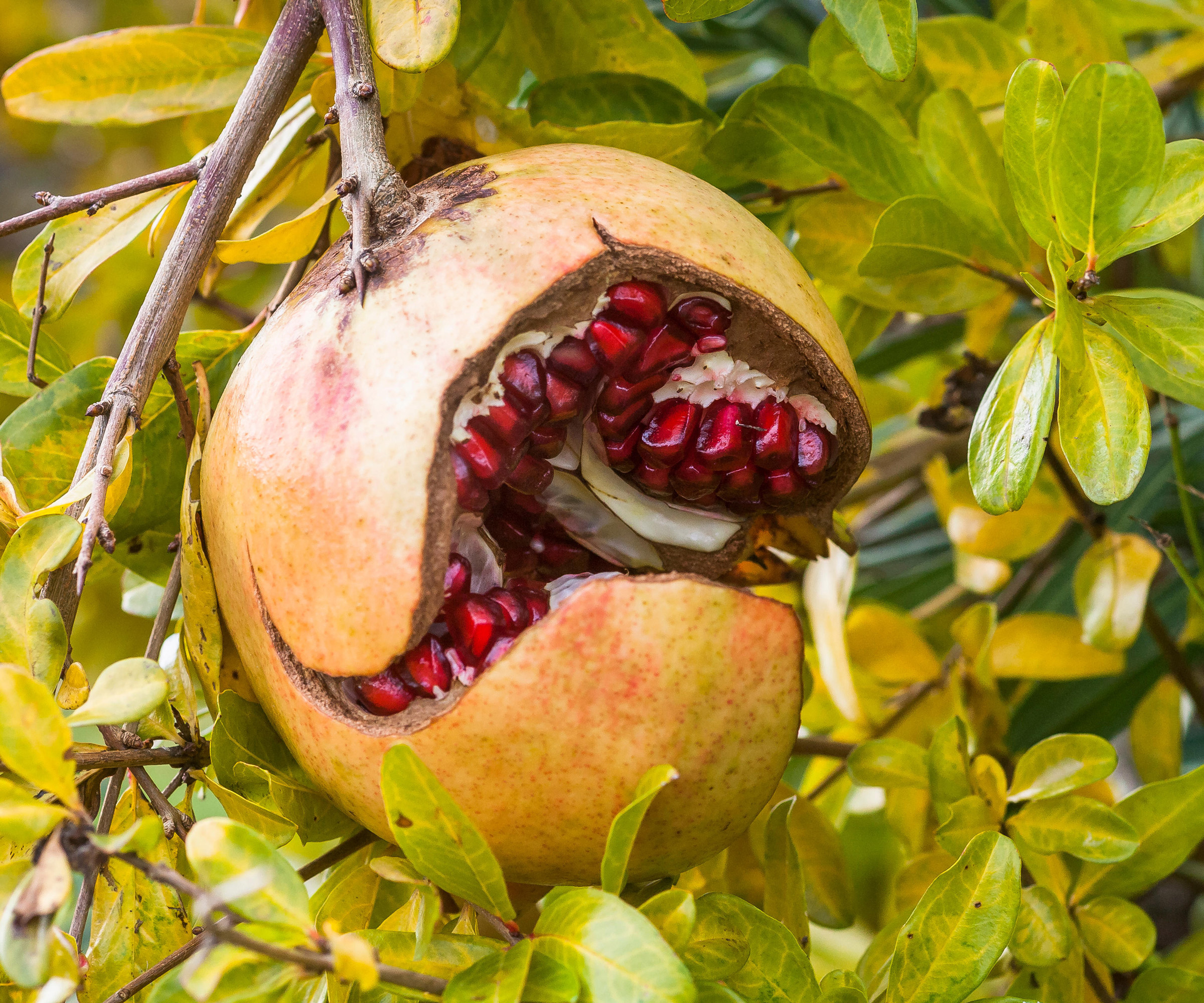
Harvesting pomegranates
As we have already explained, the most important thing about learning how to grow pomegranates is accepting that you need to devote time to the endeavour. They are not amongst the best fast-growing fruit trees to cultivate, and their berry fruits are not to be rushed – at any stage. The first flowers can take a couple of years to appear on young trees. As Maureen Wright points out, the tree spends its first two seasons after planting focusing its energy on root, stem and foliage development. Once you do see flowers (May-July), you can start to feel optimistic. Of course, then the process of waiting for the juicy arils (the fleshy seeds) is another waiting game and can take four-five months. But once a tree is established (years three-five), Maureen points out that annual fall harvests (September-October) should be steady, healthy and prolific.
Knowing exactly when to harvest is a judgement call based on changes in fruit appearance. ‘Study the shape and color of your fruit on the stem. They will lose that shiny gloss and shift to a duller, reddish color,’ says Maureen. ‘They will also shift from a round shape to a more octagon shape.’ You can also try tapping the fruit with a finger – if you hear a ‘metallic’ sound, you’re in luck. ‘Once the fruit is ready, don’t pull it off the stem,’ urges Maureen. ‘Instead, you will want to use a sterile pair of pruners (or secateurs) and cut the fruit right at the stem above.’ Undamaged fruits should keep at room temperature for a couple of weeks, and in the fridge they are good for over a month.
Finally, experts believe that pomegranate trees can live for over 100 years, so although you have to wait a while for that first harvest, healthy and happy trees will reward your patience for years to come.
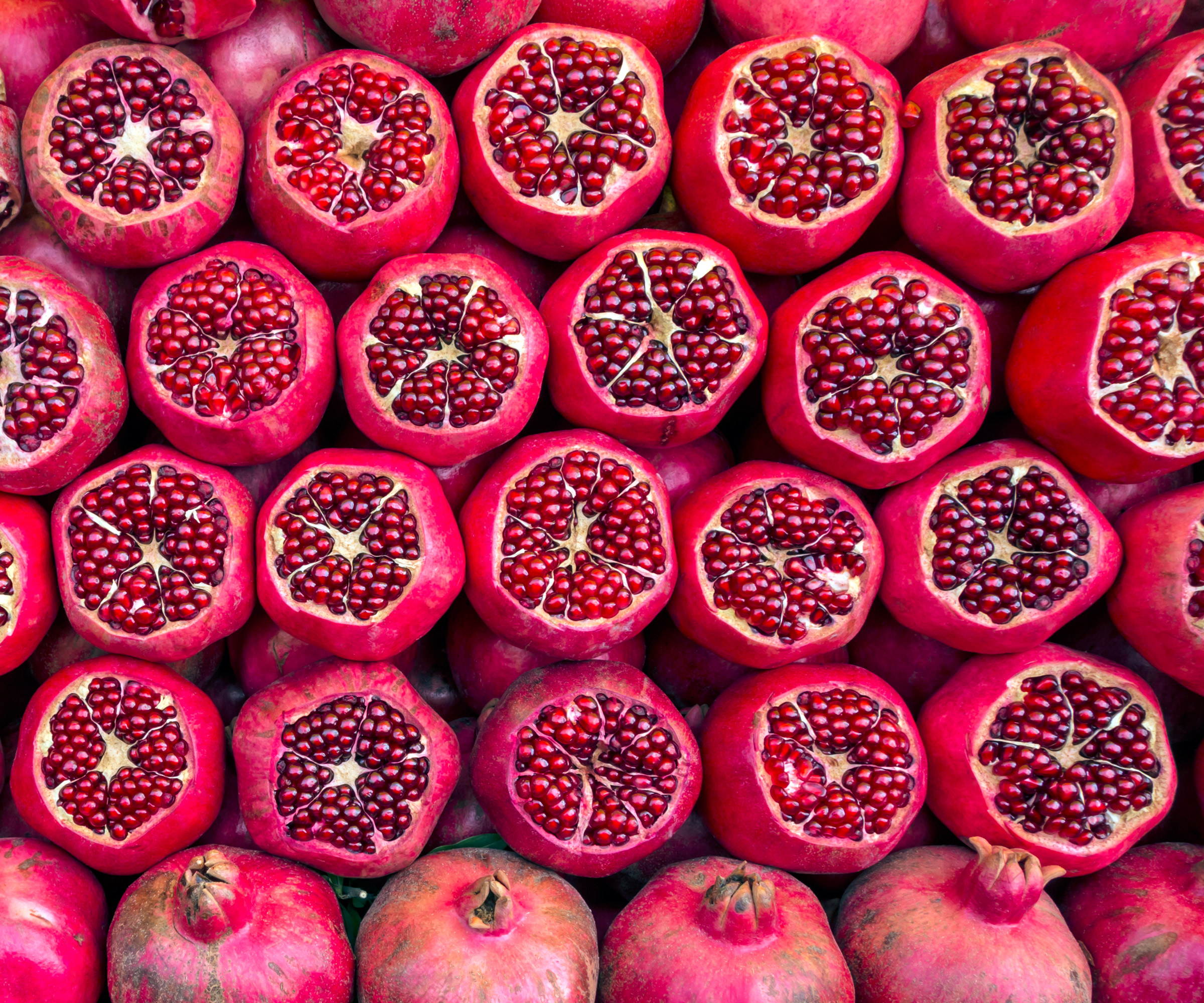
FAQs
Can you grow pomegranates from seeds?
Given all the seeds bursting out of each pomegranate, you’d be forgiven for wanting to try starting some more plants off from sowing. And yes, you can grow pomegranates by collecting seeds and planting them. It’s just you have to wait a long time for the tree to reach a point where fruits are even a possibility. And even if you do finally grow fruits this way, these pomegranates probably won’t be true to the parent tree.
To try, remove all the flesh from the seeds and dry (and ideally, keep in the fridge for a few weeks). Sow a few seeds per pot of compost. Place in a propagator until you are sure of germination, which can take two-four weeks. Keep moist and well drained at all times. Once you see seedlings, thin to the strongest per pot. Pot on or transplant out when seedlings are sprouting more than one set of true leaves. This is a fun experiment, but remember it will likely take longer to see flowers (and fruits!) from any trees started from scratch than it will from planting tree saplings.
Can you grow pomegranates from cuttings?
If you propagate pomegranates, you have a better chance of growing one that is true to its parent tree (a varietal match) if you take cuttings. The best time to propagate is by taking hardwood cuttings when the tree is dormant (late winter). To take plant cuttings, make cuts where the wood is half an inch thick, and ensure cuttings are 8-10in long. Scrape a little bark from the base of each cutting and dip in rooting hormone. Plant in pots of moist, well-draining compost in a greenhouse. Rooting can take a couple of months. (You can dip cuttings in water if you prefer; this way, roots take four-six weeks.)
Harden off and pot or plant out once you see new leaf growth in spring. You will have to wait longer for harvests than from planting a young tree. However, if you take cuttings and transplant seedlings from a tree that you know has fruited, experts believe this will give you a head-start over any tree you attempt to grow from seed.
Why are my pomegranates not making fruit?
First of all, manage your expectations if you want to grow pomegranates as crops. ‘Trees can take over a year to establish, so be patient,’ says Maureen Wright at Fast Growing Trees. ‘Trees, like people, have distinct personalities and adjust to their environment in their own time.’ It can take an average of three years to set fruit. Over time, as they flower more copiously, the odds are more in your favour. It is also not uncommon to wait until September in any given year for crops.
Still, there are a few things you can check. Make sure you are growing a cropping variety (some are bred as ornamentals). Keep a close eye on feeding, and especially watering, as irregular dips can stop crops in their tracks. Ensure soil pH is at 5.5-7, as pomegranates don’t like overly acidic or alkaline conditions. Keep in full sunshine for as long as you can, and hand-pollinate with a brush when flowers are in bloom. Prune lightly each year, and keep as warm as possible in the growing season.
What are the best ways to prune pomegranates?
Growing pomegranates is low maintenance as long as you quick to remove damaged branches, and keep new growth focused on fruit production. As Maureen Wright at Fast Growing Trees points out, one of the keys to strong pomegranate production is to remove suckers (new shoots that develop from the base). She urges you to trim any suckers you see in the first few years. That way, energy is redirected towards cropping in the upper parts of the tree. This kind of pruning guarantees better shoot development in the main body of the plant, and a more prolific season of fruit. This is one of the best ways to prune fruit trees for better yields. 'Once the tree is established, you’ll also need to prune out any dead or damaged branches,' says Maureen.
To ensure you grow the best pomegranate fruits, keep a close eye on the numbers developing on each branch. 'When the fruiting season occurs, it’s good practice to thin out some of the developing fruit,' says Maureen Wright from Fast Growing Trees. 'This encourages a larger size for the remaining fruit, and also means branches don’t get stressed from being weighed down by too much fruit,' she adds. As well as mastering the pruning rule essentials, thinning helps to encourage healthier, tastier fruits.







